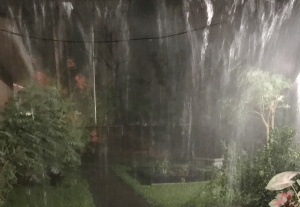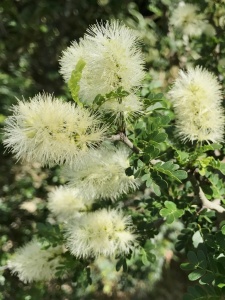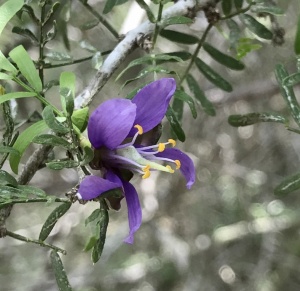A couple of weeks ago, I awoke to flashes of light visible even beneath closed eyelids, and a syncopated, steady sound I attributed to our younger cat, annoyingly delighted with one of his toys. I vaguely recall sleep-shouting, “Izzy,” into the darkness as my brain began to rouse itself into cognitive awareness.
The pulsing lights weren’t from alien space ships circling the roof, nor was the cat guilty of disturbing my sleep; the steady, near-unfamiliar noise was the constant drip of rain plopping into a small puddle outside an open bedroom window while gentle rumbles of thunder accompanied the quickly diminishing lightening. Nothing immediately visible came of that moisture event other than a tease to the earth.
Today, though, the cats and I awoke to a lovely summer storm. Not really, we rudely awoke to the ear-shattering tune of the alarm system triggered into active mode by the lovely summer storm booming and raging outside the bedroom windows.
An early morning courtyard scene outside of San Benito where 3 5/8 inches of rain fell in a three day period.

A typical intersection scene in Harlingen where rain gauges reported between 5 and 14.63 inches of rain in a 24-hour period ending June, 20.

Rain is always an exciting event here in the Deep South of Texas — any time of year — regardless its booming and flashing inconsideration during precious sleep times. What it means for the native trees is an interesting phenomenon.
Did you ever wonder . . . ?
If you’ve never thought about it, here’s something to think about. Many trees around the world have a specific season to bloom, after which they bear fruit, produce seeds, lose their leaves in preparation to hibernate through winter months; and then the cycle begins again come spring — whenever that may be — depending upon the hemisphere in which said trees are growing.
In the Valley, fortunately, for our entertainment, our native trees don’t subscribe to that strict a schedule; many native trees will bloom off and on throughout the year depending, amazingly, on the odd times that the gods of rain bless the drought-scorched Valley.
Some plants may bloom before a rain. Yes, before it rains. That’s what Harlingen’s native nurseryman and Master Naturalist’s friend, Mike Heep, announced in a presentation earlier this year. The comment certainly got my attention, and also helped me to realize my neighbor-the-farmer isn’t really all that weird.
Plants can bloom before a rain because of the higher humidity of the approaching event, according to Mike Heep.
The farmer next door has said to me many a time, “It’s going to rain. The ebony trees are blooming.” I never corrected him by telling him they bloom after it rains, not before, because I respect the fact that he’s a born and bred Valley-ite and I am not. Still, I always thought that was one old wives’ tale he just didn’t get quite right. Thanks to Mike Heep for setting me straight as I now am less skeptical of some of what the farmer tells me, although I still take a lot of his tales with a grain of salt.
Valley farmers can tell it’s going to rain when the Texas Ebony puts out flowers.

Wonderful native trees, like Tenaza, Anacua, Wright’s Catclaw, Guajillo, Guayacán, Colima, Brasil and Coma help announce spring time in the Valley when they burst into bloom February through April.
And with the magic of rain, these species also produce flowers off and on during the year after a rainfall.
I’m always ecstatic when I see the big, sprawling guayacán (Guaiacum angustifolium) blooming across from the Betty McEnery Memorial Garden along Ebony Loop in Harlingen’s Huge Ramsey Nature Park. The blooms are like tiny orchids in unusual shades of purple, pink, lavender and violet petals with bright, arty yellow anthers.

Last Thursday morning during our volunteer work, not only were there many new blossoms on the guayacán from the earlier rain, but many lyside sulphur butterflies were fluttering around the tree — hopefully looking to lay their eggs on their larval plant.
As June makes way for July, many of our native trees are busy producing fruit from spring blooms that will provide food for birds and other critters for the rest of the year.
With this week’s wonderful benefits from the off-shore Gulf un-named weather activity, many of our native trees will again begin pushing out blooms, thus, restarting the bloom-fruit-seed cycle all over again providing more native food for native birds, bugs, butterflies and critters. And the beat goes on . . . .
Please tell us your Big Rain Event stories and how much rain fell in your area — send photos and I’ll add them to this post.
